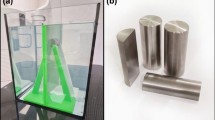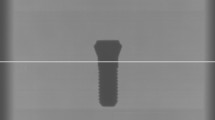Abstract
Purpose
Metallic dental implants cause severe streaking artefacts in computed tomography (CT) data, which inhibit the correct representation of shape and density of the metal and the surrounding tissue. The aim of this study was to investigate the impact of dental implants on the accuracy of dose calculations in radiation therapy planning and the benefit of metal artefact reduction (MAR). A second aim was to determine the treatment technique which is less sensitive to the presence of metallic implants in terms of dose calculation accuracy.
Materials and methods
Phantoms consisting of homogeneous water equivalent material surrounding dental implants were designed. Artefact-containing CT data were corrected using the correct density information. Intensity-modulated radiation therapy (IMRT) and volumetric modulated arc therapy (VMAT) plans were calculated on corrected and uncorrected CT data and compared to 2-dimensional dose measurements using GafChromic™ EBT2 films.
Results
For all plans the accuracy of dose calculations is significantly higher if performed on corrected CT data (p = 0.015). The agreement of calculated and measured dose distributions is significantly higher for VMAT than for IMRT plans for calculations on uncorrected CT data (p = 0.011) as well as on corrected CT data (p = 0.029).
Conclusion
For IMRT and VMAT the application of metal artefact reduction significantly increases the agreement of dose calculations with film measurements. VMAT was found to provide the highest accuracy on corrected as well as on uncorrected CT data. VMAT is therefore preferable over IMRT for patients with metallic implants, if plan quality is comparable for the two techniques.
Zusammenfassung
Ziel
Zahnimplantate aus Metall verursachen in Computertomographiedaten (CT) streifenförmige Artefakte. Diese verhindern eine korrekte Zuordnung von Form und Dichteeigenschaften des Metalls und des umgebenden Gewebes. Ziel dieser Studie war es, den Einfluss von Zahnimplantaten auf die Genauigkeit der Dosisberechnung in der Strahlentherapie zu untersuchen und zu überprüfen, ob eine reine Reduktion der Metallartefakte ohne Korrektur der Form und der Dichtewerte des Metallimplantats eine genauere Dosisberechnung ermöglicht. Als zweites Ziel sollte die Bestrahlungstechnik bestimmt werden, welche bei vorhandenen metallischen Implantaten, in Bezug auf die Dosisberechnungsgenauigkeit am wenigsten fehleranfällig ist.
Methoden und Material
Es wurden Phantome aus homogenem wasseräquivalentem Material mit Zahnimplantaten entworfen. CT-Daten welche Artefakte enthielten wurden mit den richtigen Dichtewerten korrigiert. Auf korrigierten und nichtkorrigierten CT-Daten wurden IMRT (intensity-modulated radiation therapy) und VMAT (volumetric modulated arc therapy)-Pläne berechnet und mit 2-dimensionalen Dosismessungen, welche mit GafChromic™-EBT2-Filmen durchgeführt wurden, verglichen.
Ergebnisse
Die Dosisberechnungsgenauigkeit ist für alle Pläne signifikant besser, wenn die Berechnungen auf korrigierten Daten durchgeführt wurden (p = 0,015). Berechnete und gemessene Dosisverteilungen stimmen für VMAT-Pläne signifikant besser überein als für IMRT-Pläne, sowohl bei Rechnungen auf nichtkorrigierten (p = 0,011) als auch auf korrigierten (p = 0,029) CT-Daten.
Schlussfolgerung
Für IMRT und VMAT wird die Übereinstimmung von berechneten und gemessenen Dosisverteilungen signifikant erhöht. Es wurde gezeigt, dass VMAT sowohl auf korrigierten als auch auf nichtkorrigierten CT-Daten die höchste Genauigkeit liefert. Wenn die Planqualität für beide Techniken vergleichbar ist, sollte bei Patienten mit Metallimplantaten die VMAT der IMRT vorgezogen werden.





Similar content being viewed by others
Notes
NucletronTM, “Oncentra External Beam v4.0 – Physics and Algorithms.”
References
Yazdi M, Lari MA, Bernier G et al (2011) An opposite view data replacement approach for reducing artifacts due to metallic dental objects. Med Phys 38:2275–2281
Bazalova M, Beaulieu L, Palefsky S et al (2007) Correction of CT artifacts and its influence on Monte Carlo dose calculations. Med Phys 34:2119–2132
Kim Y, Tomé WA, Bal M et al (2006) The impact of dental metal artifacts on head and neck IMRT dose distributions. Radiother Oncol 79:198–202
Roberts R (2001) How accurate is a CT-based dose calculation on a pencil beam TPS for a patient with a metallic prosthesis? Phys Med Biol 46:N227–N234
Wei J, Sandison GA, Hsi W-C et al (2006) Dosimetric impact of a CT metal artefact suppression algorithm for proton, electron and photon therapies. Phys Med Biol 51:5183–5197
Mail N, Albarakati Y, Ahmad Khan M et al (2013) The impacts of dental filling materials on RapidArc treatment planning and dose delivery: challenges and solution. Med Phys 40:081714
Spadea MF, Verburg J, Baroni G et al (2013) Dosimetric assessment of a novel metal artifact reduction method in CT images. J Appl Clin Med Phys 14:4027
Spadea MF, Verburg JM, Baroni G et al (2014) The impact of low-Z and high-Z metal implants in IMRT: a Monte Carlo study of dose inaccuracies in commercial dose algorithms. Med Phys 41:011702
Paudel MR, Mackenzie M, Fallone BG et al (2013) Evaluation of normalized metal artifact reduction (NMAR) in kVCT using MVCT prior images for radiotherapy treatment planning. Med Phys 40:081701
Paudel MR, Mackenzie M, Fallone BG et al (2014) Clinical evaluation of normalized metal artifact reduction in kVCT using MVCT prior images (MVCT-NMAR) for radiation therapy treatment planning. Int J Radiat Oncol Biol Phys 89:682–689
Dobler B, Weidner K, Koelbl O (2010) Application of volumetric modulated arc therapy (VMAT) in a dual-vendor environment. Radiat Oncol 5:95
Treutwein M, Hipp M, Koelbl O et al (2012) Searching standard parameters for volumetric modulated arc therapy (VMAT) of prostate cancer. Radiat Oncol 7:108
Alvarez-Moret J, Pohl F, Koelbl O et al (2010) Evaluation of volumetric modulated arc therapy (VMAT) with Oncentra MasterPlan(R) for the treatment of head and neck cancer. Radiat Oncol 5:110
Palma D, Vollans E, James K et al (2008) Volumetric modulated arc therapy for delivery of prostate radiotherapy: comparison with intensity-modulated radiotherapy and three-dimensional conformal radiotherapy. Int J Radiat Oncol Biol Phys 72:996–1001
Popescu CC, Olivotto IA, Beckham WA et al (2010) Volumetric modulated arc therapy improves dosimetry and reduces treatment time compared to conventional intensity-modulated radiotherapy for locoregional radiotherapy of left-sided breast cancer and internal mammary nodes. Int J Radiat Oncol Biol Phys 76:287–295
Vanetti E, Clivio A, Nicolini G et al (2009) Volumetric modulated arc radiotherapy for carcinomas of the oro-pharynx, hypo-pharynx and larynx: a treatment planning comparison with fixed field IMRT. Radiother Oncol 92:111–117
Clivio A, Fogliata A, Franzetti-Pellanda A et al (2009) Volumetric-modulated arc radiotherapy for carcinomas of the anal canal: A treatment planning comparison with fixed field IMRT. Radiother Oncol 92:118–124
Lagerwaard FJ, Meijer OW, Van Der Hoorn EA et al (2009) Volumetric modulated arc radiotherapy for vestibular schwannomas. Int J Radiat Oncol Biol Phys 74:610–615
Cozzi L, Dinshaw KA, Shrivastava SK et al (2008) A treatment planning study comparing volumetric arc modulation with RapidArc and fixed field IMRT for cervix uteri radiotherapy. Radiother Oncol 89:180–191
Pasler M, Georg D, Bartelt S et al (2013) Node-positive left-sided breast cancer: does VMAT improve treatment plan quality with respect to IMRT? Strahlenther Onkol 189:380–386
Pasler M, Wirtz H, Lutterbach J (2011) Impact of gantry rotation time on plan quality and dosimetric verification–volumetric modulated arc therapy (VMAT) vs. intensity modulated radiotherapy (IMRT). Strahlenther Onkol 187:812–819
Wiehle R, Knippen S, Grosu AL et al (2011) VMAT and step-and-shoot IMRT in head and neck cancer: a comparative plan analysis. Strahlenther Onkol 187:820–825
Kim Y, Tomé WA (2007) On the radiobiological impact of metal artifacts in head-and-neck IMRT in terms of tumor control probability (TCP) and normal tissue complication probability (NTCP). Med Biol Eng Comput 45:1045–1051
Li H, Noel C, Chen H et al (2012) Clinical evaluation of a commercial orthopedic metal artifact reduction tool for CT simulations in radiation therapy. Med Phys 39:7507–7517
Webster GJ, Rowbottom CG, Mackay RI (2009) Evaluation of the impact of dental artefacts on intensity-modulated radiotherapy planning for the head and neck. Radiother Oncol 93:553–558
Dobler B, Pohl F, Bogner L et al (2007) Comparison of direct machine parameter optimization versus fluence optimization with sequential sequencing in IMRT of hypopharyngeal carcinoma. Radiat Oncol 2:33
Snyder WS, Cook MJ, Nasset ES, Karkhausen LR, Howells GP,Tipton IH (1974) “Report of the task group on reference man,”Technical Report 23, International Commission on Radiological Protection, 1974
Tissue substitutes in radiation dosimetry and measurement (1989) International Commission on Radiation Units and Measurements Bethesda, Md., U.S.A.: International Commission on Radiation Units and Measurements (ICRU report, 44)
Menegotti L, Delana A, Martignano A (2008) Radiochromic film dosimetry with flatbed scanners: a fast and accurate method for dose calibration and uniformity correction with single film exposure. Med Phys 35:3078–3085
Micke A, Lewis DF, Yu X (2011) Multichannel film dosimetry with nonuniformity correction. Med Phys 38:2523–2534
Schneider F, Polednik M, Wolff D et al (2009) Optimization of the gafchromic EBT protocol for IMRT QA. Z Med Phys 19:29–37
Lewis D, Micke A, Yu X et al (2012) An efficient protocol for radiochromic film dosimetry combining calibration and measurement in a single scan. Med Phys 39:6339–6350
Low DA, Harms WB, Mutic S et al (1998) A technique for the quantitative evaluation of dose distributions. Med Phys 25:656–661
Ezzell GA, Burmeister JW, Dogan N et al (2009) IMRT commissioning: multiple institution planning and dosimetry comparisons, a report from AAPM Task Group 119. Med Phys 36:5359–5373
Hayashi N, Watanabe Y, Malmin R et al (2012) Evaluation of triple channel correction acquisition method for radiochromic film dosimetry. J Radiat Res 53:930–935
Dobler B, Walter C, Knopf A et al (2006) Optimization of extracranial stereotactic radiation therapy of small lung lesions using accurate dose calculation algorithms. Radiat Oncol 1:45
Otto K (2008) Volumetric modulated arc therapy: IMRT in a single gantry arc. Med Phys 35:310–317
Bortfeld T (2006) IMRT: a review and preview. Phys Med Biol 51:R363–R379
Carolan M, Dao P, Fox C et al (2000) Effect of hip prostheses on radiotherapy dose. Australas Radiol 44:290–295
Compliance with ethical guidelines
Acknowledgements
The work was supported by the Wilhelm Sander Foundation. We want to thank Walter Schäffer for providing the teeth implant material.
Conflict of interest
M. März, O. Kölbl and B. Dobler state the following: the department has a research cooperation with Elekta GmbH Hamburg. The accompanying manuscript does not include studies on humans or animals.
Author information
Authors and Affiliations
Corresponding author
Rights and permissions
About this article
Cite this article
Maerz, M., Koelbl, O. & Dobler, B. Influence of metallic dental implants and metal artefacts on dose calculation accuracy. Strahlenther Onkol 191, 234–241 (2015). https://doi.org/10.1007/s00066-014-0774-2
Received:
Accepted:
Published:
Issue Date:
DOI: https://doi.org/10.1007/s00066-014-0774-2
Keywords
- Computed tomography
- Metal artifacts
- Dental implants
- Radiotherapy
- Intensity modulated radiation therapy
- GafChromic




